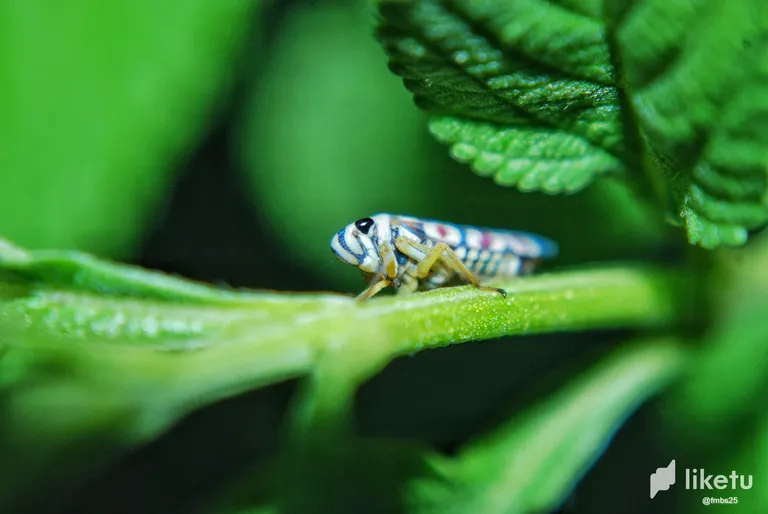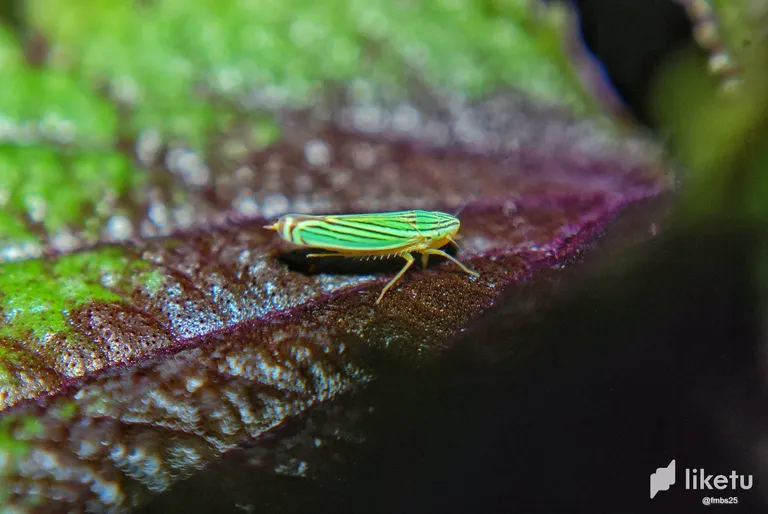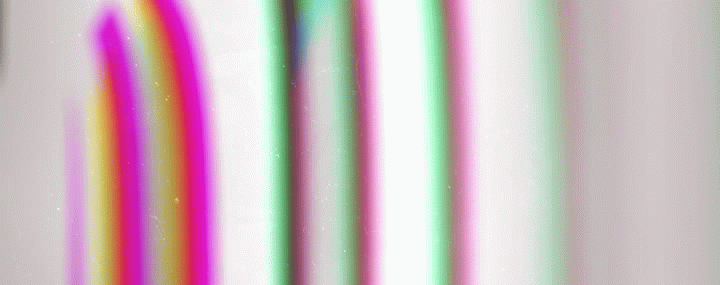






Now it was the turn of the leafhoppers, these are abundant in the garden at the end of winter, I imagine that it is the time of birth or perhaps mating, usually, the plants of witch oregano, lemon balm and now the plants of Asian mantle, which have a few months in the garden, are the favorite home of these leafhoppers, I had already shown you some images of them some time ago, but at that time they were photographs with my cell phone, now I share with you the new shots I took with the help of the macro lens of my Nikon, but I tell you something, how difficult it is to make macros to these tiny little friends! They are so small that you have to keep the camera still and at the right distance to be able to capture the detail of these little girls perfectly.
The first, who wears a party dress, is an Agrosoma Pullchela, commonly known as a chicharrita, like the second, who wears a green suit with black stripes, a < i>Sibovia Nielsoni, of both species that are familiar and belong to the Cicadellidae family, there is not much information that can be found, other than that they are leafhoppers from the American continent and that they love the tropical climate, they feed from the sap of some plants, and we know that they are doing damage to them because the leaves of these begin to dry in the center of the leaves, or where you are they have been extracting the sap.
I loved the fact of being able to focus on an ant about 100 times smaller than the cicada that was supposed to be the protagonist of the photograph, this little one was only captured in a single image, and I must say that I did not mind that the cicada looks out of focus, because the tiny ant is worth the blur, even more with how difficult it is to focus on this type of animals.
What to say about the editing, the first images, the Agrosoma Pullchela, was photographed in the afternoon, where the sunlight favored me a lot, although the plant is in shadow, it was not necessary to use extra light, while the Sibovia Nielsoni was photographed at night, for which the extra lamp was necessary, however, I must say that the latter did not make me feel very happy, I think I will try again some extra shots, the Asian mantle has many of them. As for editing, I played a lot with the brightness, cold tones and shadows, in order to highlight the natural colors of both the background plants and the cicadas themselves.
Images owned by me, taken on my Nikon D80 camera, edited with Snapseed
Thank you for taking the time to read this post, if you have any questions, criticisms or suggestions, I would appreciate it if you put them in the comment box, and remember, you too can work magic on the kitchen and wherever you go!
______________________________
______________________________

Created by @derangedvisions
The first, who wears a party dress, is an Agrosoma Pullchela, commonly known as a chicharrita, like the second, who wears a green suit with black stripes, a < i>Sibovia Nielsoni, of both species that are familiar and belong to the Cicadellidae family, there is not much information that can be found, other than that they are leafhoppers from the American continent and that they love the tropical climate, they feed from the sap of some plants, and we know that they are doing damage to them because the leaves of these begin to dry in the center of the leaves, or where you are they have been extracting the sap.
I loved the fact of being able to focus on an ant about 100 times smaller than the cicada that was supposed to be the protagonist of the photograph, this little one was only captured in a single image, and I must say that I did not mind that the cicada looks out of focus, because the tiny ant is worth the blur, even more with how difficult it is to focus on this type of animals.
What to say about the editing, the first images, the Agrosoma Pullchela, was photographed in the afternoon, where the sunlight favored me a lot, although the plant is in shadow, it was not necessary to use extra light, while the Sibovia Nielsoni was photographed at night, for which the extra lamp was necessary, however, I must say that the latter did not make me feel very happy, I think I will try again some extra shots, the Asian mantle has many of them. As for editing, I played a lot with the brightness, cold tones and shadows, in order to highlight the natural colors of both the background plants and the cicadas themselves.
Thank you for taking the time to read this post, if you have any questions, criticisms or suggestions, I would appreciate it if you put them in the comment box, and remember, you too can work magic on the kitchen and wherever you go!
[ES]
Ahora le tocó el turno a las chicharritas, estas abundan en el jardín a finales del invierno, imagino que es época de nacimiento o quizá de apareamiento, por lo general, las plantas de orégano brujo, toronjil y ahora las plantas de manto asiático, que tienen pocos meses en el jardín, son el hogar predilecto de estas chicharras, ya les había mostrado algunas imágenes de ellas hace un tiempo, pero en aquella oportunidad eran fotografías con el móvil, ahora les comparto las nuevas tomas que le hice con ayuda del lente macro de mi Nikon, pero les cuento algo, ¡Que difícil es hacerle macros a estas diminutas amiguitas! Son tan pequeñas que mantener la cámara inmóvil y a la distancia correcta para poder capturar el detalle a la perfección de estas chiquillas
La primera, que lleva un vestido de fiesta, se trata de una Agrosoma Pullchela, a la que comúnmente se le conoce como chicharrita, al igual que la segunda que viste un traje verde con rayas negras, una Sibovia Nielsoni, de ambas especies que son familiares y pertenecen a la familia de Cicadellidae, no es mucha la información que se puede encontrar, más que son chicharritas procedentes del continente americano y que aman el clima tropical, se alimentan de la savia de algunas plantas, y sabemos que están haciéndole daño a las mismas porque las hojas de estas se empiezan a secar en el centro de las hojas, o donde estás han estado extrayendo la savia.
Ame el hecho de poder enfocar una hormiga unas 100 veces más diminuta que la chicharrita que se suponía era la protagonista de la fotografía, esta pequeña solo fue capturada en una sola imagen, y debo decir que no me importo que la chicharrita se vea bien desenfocada, pues la diminuta hormiga vale el desenfoque, más aún con lo difícil que es enfocar este tipo de animalitos.
Que decir de la edición, las primeras imágenes, la Agrosoma Pullchela, fue fotografiada en la tarde, en donde la luz del sol me favorecía mucho, aunque la planta está en sombra, no fue necesario utilizar luz extra, mientras que la Sibovia Nielsoni fue fotografiada de noche, para lo que si fue necesaria la lámpara extra, sin embargo, debo decir que estas últimas no me hicieron sentir muy conforme, creo que intentaré nuevamente unas tomas extra, el manto asiático tiene muchas de ellas. En cuanto a edición, jugué mucho con el brillo, los tonos fríos y las sombras, para poder resaltar los colores naturales tanto de las plantas de fondo como de las chicharritas en sí.
Imágenes de mi propiedad, tomadas mi cámara Nikon D80, editadas con Snapseed
Gracias por tomarse el tiempo de leer esta publicación, si tiene alguna pregunta, crítica o sugerencia, la agradecería que la pusiera en la caja de comentarios, y recuerda, ¡Tú también puedes hacer magia en la cocina ya dondequiera que vayas!

Created by @robinsonlgil

La primera, que lleva un vestido de fiesta, se trata de una Agrosoma Pullchela, a la que comúnmente se le conoce como chicharrita, al igual que la segunda que viste un traje verde con rayas negras, una Sibovia Nielsoni, de ambas especies que son familiares y pertenecen a la familia de Cicadellidae, no es mucha la información que se puede encontrar, más que son chicharritas procedentes del continente americano y que aman el clima tropical, se alimentan de la savia de algunas plantas, y sabemos que están haciéndole daño a las mismas porque las hojas de estas se empiezan a secar en el centro de las hojas, o donde estás han estado extrayendo la savia.
Ame el hecho de poder enfocar una hormiga unas 100 veces más diminuta que la chicharrita que se suponía era la protagonista de la fotografía, esta pequeña solo fue capturada en una sola imagen, y debo decir que no me importo que la chicharrita se vea bien desenfocada, pues la diminuta hormiga vale el desenfoque, más aún con lo difícil que es enfocar este tipo de animalitos.
Que decir de la edición, las primeras imágenes, la Agrosoma Pullchela, fue fotografiada en la tarde, en donde la luz del sol me favorecía mucho, aunque la planta está en sombra, no fue necesario utilizar luz extra, mientras que la Sibovia Nielsoni fue fotografiada de noche, para lo que si fue necesaria la lámpara extra, sin embargo, debo decir que estas últimas no me hicieron sentir muy conforme, creo que intentaré nuevamente unas tomas extra, el manto asiático tiene muchas de ellas. En cuanto a edición, jugué mucho con el brillo, los tonos fríos y las sombras, para poder resaltar los colores naturales tanto de las plantas de fondo como de las chicharritas en sí.
Gracias por tomarse el tiempo de leer esta publicación, si tiene alguna pregunta, crítica o sugerencia, la agradecería que la pusiera en la caja de comentarios, y recuerda, ¡Tú también puedes hacer magia en la cocina ya dondequiera que vayas!



For the best experience view this post on Liketu
This post has been manually curated by @steemflow from Indiaunited community. Join us on our Discord Server.
Do you know that you can earn a passive income by delegating to @indiaunited. We share more than 100 % of the curation rewards with the delegators in the form of IUC tokens. HP delegators and IUC token holders also get upto 20% additional vote weight.
Here are some handy links for delegations: 100HP, 250HP, 500HP, 1000HP.
100% of the rewards from this comment goes to the curator for their manual curation efforts. Please encourage the curator @steemflow by upvoting this comment and support the community by voting the posts made by @indiaunited.
Yay! 🤗
Your content has been boosted with Ecency Points, by @birdwatcher.
Use Ecency daily to boost your growth on platform!
Support Ecency
Vote for new Proposal
Delegate HP and earn more